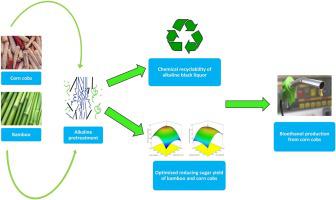Industrial Crops and Products ( IF 5.6 ) Pub Date : 2021-10-20 , DOI: 10.1016/j.indcrop.2021.114166 Milesh Laltha 1 , Y. Sewsynker-Sukai 2 , Gueguim Kana E.B. 1

|
The present study optimized two microwave-assisted alkaline (Na3PO4.12H2O and NaOH) pretreatment methods for the enhancement of sugar recovery from different lignocellulosic substrates (bamboo and corn cobs) with varying structural compositions. Subsequently, the chemical recyclability of the optimized alkaline pretreatments were evaluated on corn cobs. Furthermore, kinetics of microbial cell growth and bioethanol production in simultaneous saccharification and fermentation (SSF) processes were assessed. The optimized Na3PO4.12H2O pretreatment conditions resulted in the maximum reducing sugar yield (0.512 g/g) from corn cobs. Interestingly, the recyclability studies demonstrated that the NaOH-based black liquor resulted in a slightly higher average sugar yield (0.37 g/g) compared to the Na3PO4.12H2O (0.31 g/g) over three pretreatment cycles. Kinetics showed a maximum specific growth rate and maximum potential bioethanol concentration of 0.175 h−1 and 16.928 g/L respectively for the optimized NaOH pretreated corn cobs. The findings from this study provide significant knowledge enhancements pertaining to the use of gold standard, well-known NaOH methods, in addition to the emerging Na3PO4.12H2O alkaline catalyst for the pretreatment of lignocellulosic substrates with varying structural compositions. Moreover, recyclability of Na3PO4.12H2O and NaOH black liquor demonstrated the potential to reduce costs associated with the application of chemicals and fresh water in pretreatment systems. Kinetics of cell growth and bioethanol production elucidates noteworthy indices such as the maximum specific growth rate of the cells, lag time and maximum bioethanol production for lignocellulosic process development and scale-up procedures.
中文翻译:

开发微波辅助碱性预处理方法以提高竹子和玉米芯的糖分回收率:工艺优化、化学可回收性和生物乙醇生产动力学
本研究优化了两种微波辅助碱性(Na 3 PO 4 .12H 2 O 和 NaOH)预处理方法,以提高从具有不同结构组成的不同木质纤维素基质(竹子和玉米芯)中回收糖分的方法。随后,在玉米芯上评估了优化的碱性预处理的化学可回收性。此外,还评估了同步糖化和发酵 (SSF) 过程中微生物细胞生长和生物乙醇生产的动力学。优化后的 Na 3 PO 4 .12H 2O 预处理条件导致玉米芯的最大还原糖产量 (0.512 g/g)。有趣的是,可回收性研究表明,在三个预处理循环中,与 Na 3 PO 4 .12H 2 O (0.31 g/g)相比,基于 NaOH 的黑液导致平均糖产量 (0.37 g/g) 略高。动力学显示优化的 NaOH 预处理玉米芯的最大比生长速率和最大潜在生物乙醇浓度分别为 0.175 h -1和 16.928 g/L。除了新兴的 Na 3 PO 4 .12H 2之外,这项研究的发现还提供了有关使用金标准、众所周知的 NaOH 方法的重要知识增强O 碱性催化剂,用于预处理具有不同结构组成的木质纤维素基材。此外,Na 3 PO 4 .12H 2 O 和NaOH 黑液的可回收性证明了降低与在预处理系统中使用化学品和淡水相关的成本的潜力。细胞生长和生物乙醇生产的动力学阐明了值得注意的指标,例如细胞的最大比生长速率、滞后时间和木质纤维素工艺开发和放大程序的最大生物乙醇生产。









































 京公网安备 11010802027423号
京公网安备 11010802027423号